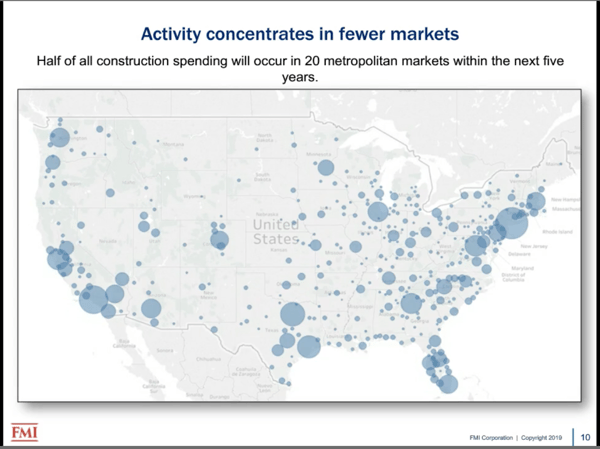Do you remember the story of the grasshopper and the ant? In this ancient fable, the grasshopper spends the summer dancing and playing while the ant works hard to store food for the inevitable winter. When winter comes, the ant is prepared while the grasshopper suffers because he has wasted his opportunity to prepare like his friend the ant.
Those that have been the construction business long enough understand its cyclical nature. We know that every few years we will feel a slow-down. Our current economic boom has now entered its 10th year. It’s the longest expansion any of us have experienced, and we’ve all been enjoying a decade of growth across virtually all geographies and market sectors. A nice payback after the Great Recession!
In case you’re not aware, there is an entire segment of our industry dedicated to watching leading indicators, trying to predict when the next downturn will happen. The fact that we’ve experienced a longer than normal expansion has created some anxiety. Everyone knows it will happen, it’s just a matter of WHEN. No one wants to get surprised. Watching these leading indicators and historical patterns is a good practice. You can refer to this article for 6 leading indicators to watch.
The following links from 3 national industry groups provide a snapshot of their forecasts for 2020 and beyond:
Although there seems to be a consensus that 2020 will continue to be a growth year, it’s never too early to start preparing for the next downturn. Making moves now to prepare your business for the anticipated (but unpredictable and unscheduled) downturn is good business. In this 3-part series we will touch on strategies you can use to prepare your construction business for the inevitable.
Read: Post Coronavirus Construction Predictions
Part 1: Business is Local
Although any downturn will impact the construction economy, it will not be felt uniformly across the nation. It will affect some areas of the country, and some market sectors, more than others. Some market sectors will dry up while others will flourish. Certain areas of the country will experience more or less effect than others due to our diverse economy. Stated plainly, an economic shift will look different in California than it will in Texas, New York, or Georgia.
This graphic from FMI represents a projection of where activity will be concentrated throughout the US over the next 5 years:

Diversifying your business by either entering new markets (geographically, market sectors) or creating new revenue streams (adding services, project types) are excellent strategies for riding out a downturn.
 But how does a construction business or contractor determine what areas, services and sectors to remain in and which ones to enter? Your first step is to understand what drives the economy in your neck of the woods and then ask yourself:
But how does a construction business or contractor determine what areas, services and sectors to remain in and which ones to enter? Your first step is to understand what drives the economy in your neck of the woods and then ask yourself:
- What market sectors are we in now?
- How do we procure our work in that sector?
- What is the barrier to entry for new competition?
- How might an economic downturn affect the sector(s) we work in?
- How might a shift in the economy affect my city or region?
Once you have analyzed your current state, ask yourself:
- What market sectors might fare better in a downturn?
- Are those sectors close to what we do now?
- Who do we know that’s already in that market or sector, or who would be our competition?
- How can we position ourselves to already be in that market BEFORE others?
- What can we do now to break into that market?
Fact: It takes time and resources to break into new markets and sectors. If you wait until you’re already feeling the effects of a slowdown, it’ll probably be too late to learn new skills, shift your workforce, establish competency, or gain a foothold in that market.
Financial market and economic corrections are beyond your control as a business leader. However, you do have control over your services and where and how you deploy your resources. Being brutally honest about how balanced your business is to withstand market corrections is something that should be analyzed annually as part of your overall business planning and strategy process.
Ready to start planning your downturn strategy but not sure where to start? The team as Ascent Consulting is here to help.
Book your FREE performance consultation now.
If you're ready to start working on your business, let's talk!
Ascent Consulting’s mission is to Build Better Construction Companies.
We are committed to delivering impressive results in the areas of
profitability, performance and growth.

Construction expert Jeff Robertson brings 30+ years of industry knowledge to his consulting projects. He's worked in many sectors ranging from healthcare and retail to multi-family and senior living.







Leave a Comment
Your email address will not be published. Required fields are marked *